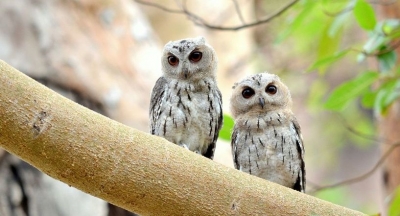
The collared scops owl, or Otus lettia, is the largest of the scops owl species and belongs to the family Strigidae. It was described for the first time by Brian Houghton Hudgson in 1836. It is found in northern India and Pakistan, Nepal, Bangladesh, south China and Taiwan, typically in evergreen forests, woodlands and deciduous forests.
It is a light gray bird with an off-white facial disc rimmed in black. Its upper parts are light beige mottled by black and dark brown markings. Its eyes are dark brown and it has long, spotted ear tufts and an off-green beak. It has rounded wings, feathered legs and gray-brown toes and claws. The bosom and belly are creamy brown. This owl is known as the king of camouflage as it blends into the nearby branches and is indistinguishable against any brown background.
It prefers to eat grasshoppers, birds, beetles and other insects and will occasionally consume lizards, rodents and frogs. It communicates by hooting and the length of the hoot depends on the nature of the call.
The female lays 3 to 5 eggs which are incubated by both parents over the period of a month. This species is spread across a large range and its population is steady. It is listed under ‘Least Concern’ by the IUCN.
Picture Credit : Google




